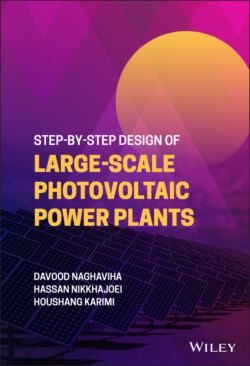Читать книгу Step-by-Step Design of Large-Scale Photovoltaic Power Plants - Houshang Karimi - Страница 20
1.4 Perspective of PV Power Plants
ОглавлениеTo predict the growth of large‐scale PV plants, the advantages and disadvantages of PV plants should be identified. A more realistic vision about the future of PV plants can be imagined by considering the fundamental crises of global energy consumption and the leading policies for its resolution. In this section, some of the advantages and disadvantages of the grid‐connected PV plants are discussed.
The most important advantages of the grid‐connected PV plants are:
Worldwide availability.
Long life of 20–30 years.
Low depreciation due to the lack of mechanical and thermal machinery.
Ability to generate on‐site consumption and save on energy transmission and distribution costs.
Low installation time (less than two years).
Low maintenance costs and ease of operation.
No production costs including the costs of fuel, marketing, and wages.
Usable in remote areas.
Generation of clean energy with no pollution.
Insignificant use of water.
Providing employment opportunities.
Independency on fossil fuels.
The most important disadvantages of the grid‐connected PV plants are:
Occupying a large land area.
No energy production at night without energy storage system.
High investment cost in addition to investment barriers.
Reduced output power at high temperatures and at the end of operation period.
Requiring a land suitable for construction and having access to the power network.
Different electricity purchase policies in different countries.
Taking time to obtain construction permits.
Some of the crises in the global energy demand and environment are:
Annual increase in energy demand.
Limited fossil fuel resources.
Increased environmental pollution from fossil fuels.
Increased CO2 emission in the atmosphere, causing global warming.
Frequent and severe storms, drought, and sea level rises.
Given the PV plants advantages and disadvantages and global energy crises, it turns out that a large numbers of PV plants are needed to achieve long‐term climate goals and to address the energy crises. Therefore, a significant growth of PV plants across the planet is expected in the near future.
The International Energy Agency (IEA) has forecast the global installed solar plants capacity by 2030 as shown in Figure 1.15. This prediction is based on considering various scenarios as described below [10].
There are uncertainties during the Covid‐19 pandemic, its economic and social impacts, and the policy responses. The stated policies assume that the Covid‐19 is gradually brought under control in 2021, and the global economy returns to pre‐pandemic levels in the same year.
The delayed recovery scenario is designed with the same policy assumptions as in the stated policies scenario, but a prolonged pandemic causes lasting damage to economic prospects. The global economy returns to its precrisis size only in 2023, and the pandemic ushers in a decade with the lowest rate of energy demand growth since the 1930s.
The sustainable development scenario assumes the energy system on track to achieve sustainable energy objectives in full, including the Paris Agreement, energy access, and air quality goals.
The new net‐zero emissions by 2050 case (NZE2050) extend the sustainable development scenario analysis. A rising number of countries and companies are targeting net‐zero emissions by midcentury. These are achieved in the sustainable development scenario, putting global emissions on track for net‐zero by 2050. The NZE2050 includes the first detailed IEA modeling of what would be needed in the next 10 years to put global CO2 emissions on track for net zero by 2050 [10].Figure 1.15 Global solar PV and coal‐fired installed capacity by scenario, 2010–2030.Source: IEA [10].
Based on the IEA forecasts about the PV plant installation capacity, it can be concluded that:
For the stated policies scenario, the PV plant installation capacity grows to about 250%.
For the sustainable development scenario, the PV plant installation capacity increases to about 420%.
For the NZE2050 scenario, the PV plant installation capacity grows to about 530%.
As a result, for the worst‐case scenario, a PV plant installation capacity of 1250 GW is expected to be added to the existing capacity by 2030.
